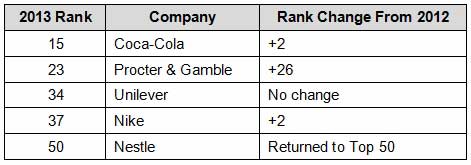Brand marketing and new product development have radically changed from the days portrayed by Don Draper and his team in AMC's "Mad Men" TV series. Back in the '50s and '60s, mass marketing/advertising/new products seemed to be more art than science. Intuition, gut feel, and luck seemed to have more to do with the success of brands and new products than did a disciplined process.
However, since then, sophisticated analytical and process models have come to the fore. Though many of the new tools and approaches have their place, I would argue that some have come at the expense of solid strategic and creative thinking.
That gap in thinking means that brand and new product innovations have not been as "disruptive" as they were in the past—and they lack real competitive advantages. Among the reasons for that are the following:
- Retailer and manufacturer consolidation. Unfortunately, stock price pressures from Wall Street have created a myopic view of how to effectively manage and grow businesses—particularly in consumer product companies. The number of retailers and manufacturers serving consumers has radically dwindled since the '60s. A lot of companies and retailers either no longer exist or are now part of bigger concerns. The result has been lower headcount, lower tolerance for long-term payback, and lower new product activity.
- The retail landscape continues to shift. Brick and mortar outlets have been losing share to online outlets because of consumer "showrooming" purchase behaviors. Moreover, private label/control brands now comprise roughly 25% of all retail sales dollars, according to the Private Label Manufacturers Association, thus decreasing the importance of national brands. Finally, lack of store buyer continuity and buying habits continue to put downward pressure on retail prices—even if a disruptive new product is launched.
- Consumer demographics have shifted. Millennials are changing the face of marketing forever, according to the Boston Consulting Group. Millennials will likely outnumber Baby Boomers 78 million to 56 million by 2030. This ascendant segment will have habits and purchase behaviors different from those of Boomers; in turn, that will have an impact on the marketing activities intended to reach them.
- Marketing and Information Technology are merging. The growth of social media, along with more sophisticated analytical tools, is bringing these two functions together. Since more media is now both traditional and digital, older marketers need to better understand social media and tactics and become more "tech savvy," while younger marketers need to gain a better understanding of strategy. Allocation of marketing dollars to the most effective media channel for driving sales is critical.
- Idea generation/intellectual property have become too narrowly defined. Traditionally, idea generation and intellectual property were sequential activities—you had to have good ideas before you had a patentable intellectual property. However, some companies have recognized good ideas can come from anywhere—both from inside and outside. As a result, they have formalized their idea generation and intellectual properties processes to ensure they have both sustainable and robust streams of new product/business ideas (such as P&G).
As a result of those trends, many consumer product companies are losing or have already lost their competitive edge and advantages, and they are not really innovating any longer. The evidence is in Boston Consulting Group's whitepaper titled "The Most Innovative Companies 2013."
In this report, BCG continues to track the state of innovation via interviews with 1,500 senior executives who rate and rank their own companies as well as the competition. The report ranks the 50 most innovative companies and reports their movement up/down this list over time. The sad fact from the latest report is that only five consumer product companies are listed among the top 50:

So what can you do to make sure your new product programs have the right kinds of competitive advantages? I would argue you need to think big and "outside the box." You need to persuade your CEO and CFO that investment in new product initiatives are worth the time and effort—despite the risks.
That said, you do need to prepare a compelling case or basis of interest so other senior line managers can better see the opportunities. You can do so by following 10 steps:
- Really understand your consumer/customer. Figure out what really motivates your customers/consumers to purchase your product or service. This could mean going beyond just focus groups to real quantitative analysis that gets to the core of purchase behaviors and attitudes.
- Think big. Think outside the box. Remember that the customer/consumer might not think about your product category in the same way you do. Creativity, intuition, and gut feel really count; if you need help, get it.
- Involve more than just marketing people. Although marketing people usually drive new products, they don't know everything. Good ideas can come from functions other than Marketing... and also from your customers who resell to the ultimate end user. They see what your competitors are doing.
- Test the validity of your ideas/concepts and prioritize them. Once you have a range of ideas, you need a way to quickly screen them with the right target consumer. Quick concept market research screens are usually the best way.
- Put together alternative business propositions. At this point, you need to summarize your top product ideas so senior management can better judge their attractiveness relative to other options. I recommend a "single sheet of paper" approach summarizing the opportunity, barriers to entry, product line strategy/expansion potential, and rough unit/$ volume potential.
- Use a new product development process. If you don't have a new product development process... get one. There are many staged tollgate new product models that can fit your business. Each "approved" business proposition should have its own tracking model and metrics for go/no-go decisions.
- Put together new product road maps. Product lifecycles are now incredibly short because of a combination of changing consumer needs and competitive offerings. You should plan a multiyear new product road map outlining what could be follow-up innovations to extend their new product lifecycle.
- If you sell to a reseller, be sure to highlight the opportunity from their perspective. You need something to give your reseller (retailer) a reason to stock and carry the product. Otherwise, end users might not ever see your idea.
- Put together a comprehensive marketing plan. You will need to "broadcast" your new product news so customers/consumers can see it in the marketplace. Don't just assume consumers will "find" your product on the Internet or via word-of-mouth.
- Go back to re-evaluate whether your new product programs were successful. Once you launch a new product or service, it should be re-evaluated to see whether it performed as expected—and if not, why not?
Developing and launching new products is challenging—no doubt about it. However, if your business follows the above steps you should have much greater probability of success. You need to assume your competition ALWAYS knows as much or more than you with end users. If you keep this in mind, don't be surprised if you show up on future most innovative company lists.




